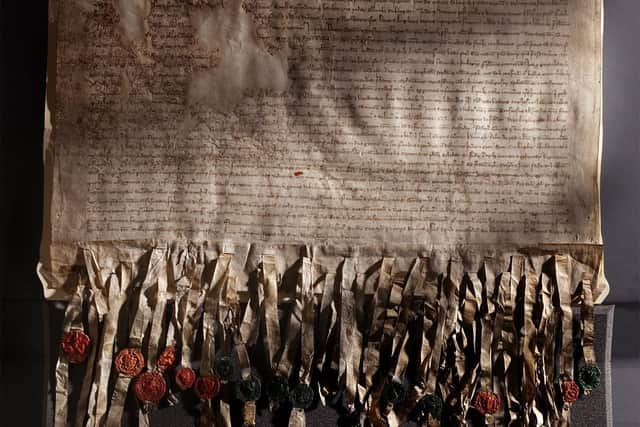Declaration of Arbroath to go on show to public for first time in 18 years
The electrifying political document, a letter written in 1320 asking Pope XXII to recognise Scotland’s independence and Robert the Bruce its lawful King, will be displayed at National Museums of Scotland (NMS) in June. Written in Latin, the Declaration was sealed by eight earls and around 40 barons and authenticated by seals of its supporters, although only 19 of them now survive.
Its display at NMS represents a rare opportunity to view the document, which can only be shown occasionally to ensure its long-term preservation.
Advertisement
Hide AdAdvertisement
Hide AdAlice Blackwell, senior curator of medieval archaeology and history at NMS, said: “We are delighted to have the opportunity to display the Declaration of Arbroath here at the National Museum of Scotland. It is a hugely significant document and a vital piece of Scotland’s history. We look forward to welcoming many visitors to enjoy the rare opportunity of seeing this iconic document close up.”


The Declaration was initially due to be displayed in April 2020 to coincide with its 700th anniversary, but was postponed due to the pandemic. It was last displayed 18 years ago at the Scottish Parliament.
The letter was written during the Wars of Independence with England when, despite the Scots’ success at the Battle of Bannockburn, Robert I had not been recognised as king by either Edward II or by the Pope, who had excommunicated him.
At this time, the Pope desired peace between England and Scotland so both could help in a crusade to the Holy Land. The Declaration sought to influence him by offering the possibility of support from the Scots for his long-desired crusade if they no longer had to fear English invasion.
Crucially, the document extends the community of the realm beyond the King and nobles to the people themselves, giving them the right to choose the king and depose him if he subjected the kingdom to English rule.
The Declaration was probably drafted at a meeting of the King and his council at Newbattle before being written up in the scriptorium of Arbroath Abbey.
After receiving the Declaration, the Pope urged reconciliation between the warring sides and a truce was agreed in 1323. A peace treaty was signed five years later and the following year the Pope issued a papal bull permitting the anointing and crowning of a King of Scots. The peace was short-lived, however, as the Second War of Independence broke out in 1332 and went on for 25 years.
Culture secretary Angus Robertson said: “The Declaration of Arbroath is of great historic and cultural interest to Scots and people around the world of Scottish descent. The display of this iconic document will give people from across Scotland and further afield a wonderful opportunity to visit the museum and see this important piece of history for themselves.”
Advertisement
Hide AdAdvertisement
Hide AdLaura Mitchell, deputy keeper of the National Records of Scotland, the custodians of the document, said: “The Declaration of Arbroath is a key treasure in our extensive collections and we are proud of the role we play in conserving this significant historical artefact for future generations. The display will allow Scots and visitors from further afield to see this famous document.”
The Declaration of Arbroath will go on show at NMS from Saturday, June 3 to Sunday, July 2.
Comments
Want to join the conversation? Please or to comment on this article.